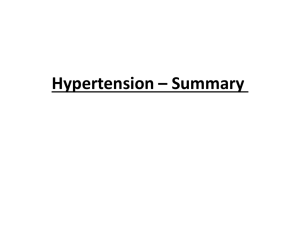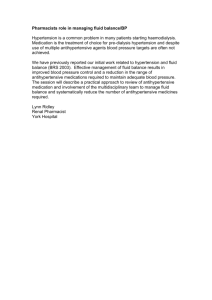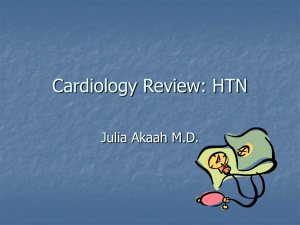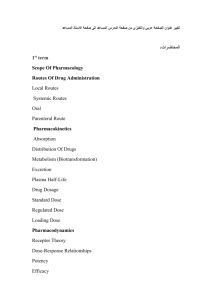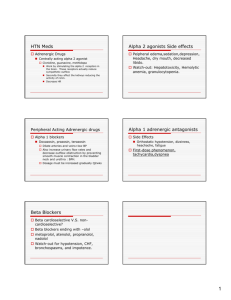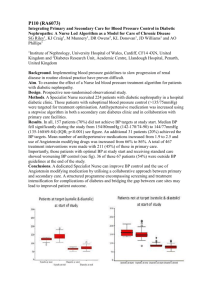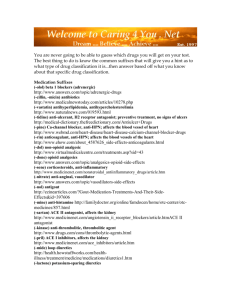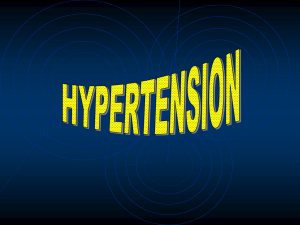Antihypertensive Agents. DiureticAgents. Antilipidemic Agent
advertisement
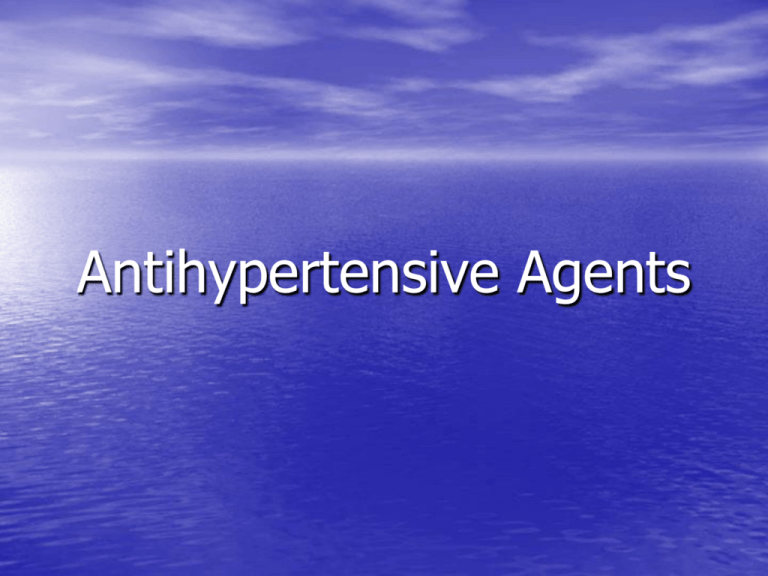
Antihypertensive Agents Hypertension High blood pressure • Normal: Systolic < 130 mm Hg Diastolic < 85 mm Hg Classification of Blood Pressure Category Hg) Systemic BP (mm Hg) Diastolic BP (mm Normal <130 <85 High normal 130-139 85-89 Hypertension Stage 1 Stage 2 Stage 3 Stage 4 140-159 160-169 180-209 210 90-99 100-109 110-119 120 Classification of Blood Pressure Primary Hypertension • Specific cause unknown • 90% of the cases • Also known as essential or idiopathic hypertension Secondary Hypertension • Cause is known (such as eclampsia of • pregnancy, renal artery disease, pheochromocytoma) 10% of the cases Blood Pressure = CO x SVR • CO = Cardiac output • SVR = Systemic vascular resistance Blood Pressure = Cardiac Output X Peripheral Resistance Preload Contractility Heart Rate Vasoconstriction Venous Arteriolar Venous Circulating Fluid Volume Renal Sodium Handling Sympathetic Nervous System Renin Angiotensin Aldosterone System Vascular remodeling Vascular Smooth Muscle Afterload a2 Volume Kidneys Vasomotor center Cardiac Output Heart b1 Renin b1 Ang I Preload Ang II Aldosterone b2 BP= CO x TPVR Capacitance venules Resistance arterioles TPVR Total Peripheral Vascular Resistance (TPVR) a1 VSMCs Vascular Smooth Muscle Cells Antihypertensive Agents • Medications used to treat hypertension Antihypertensive Agents Therapeutic goals in hypertension To lower the high blood pressure and reduced cardiovascular morbidity and mortality by least intrusive means. For most of the HTN patients: life-long treatment of an asymptomatic disease Antyhepertensive Drugs New End-Points Effects on hard end-points Mortality Stroke Heart attacks Effects on end-organ damage Left ventricular and vascular hypertophy Effects on renal function Effects on metabolic status Blood lipids and glucose Antihypertensive Agents: Categories • Adrenergic agents • Angiotensin-converting enzyme inhibitors • Angiotensin II receptor blockers • Calcium channel blockers • Diuretics • Vasodilators Antihypertensive Agents: Categories • Adrenergic Agents – Alpha1 blockers – Beta blockers (cardioselective and nonselective) – Centrally acting alpha blockers – Combined alpha-beta blockers – Peripheral-acting adrenergic agents Beta Blockers ( … lol) Afterload a2 Volume Kidneys Vasomotor center Cardiac Output Heart b1 Renin b1 Ang I Preload Ang II Aldosterone b2 BP= CO x TPVR a1 VSMCs Capacitance venules Resistance arterioles TPVR b - Blockers Beta Blockers _____________________________ Mechanisms and Sites of Action _ - Reduction in cardiac output - Inhibition of renin release Negative Chronotropic- CNS effects in venous return & Inotropic Effects - Reduction and plasma volume - Reduction in peripheral resistance - Improvement in vascular compliance - Resetting of baroreceptor levels - Effects on prejunctional b2 receptors Inhibition of - Attenuation of pressor response to catecholamines (stress, exercise) Renin Release _____________________________ _ Beta Blockers Cardioselectivity (Beta-1 vs Beta-2 ) Intrinsic Sympathomimetic Activity (ISA; partial agonistic activity) Affinity for alpha-1 adrenergic receptors (Labetalol, Carvedilol) Beta Blockers There are 15 Beta blockers on the market in the US Approved for hypertension (13) and for one or more of following indications: Angina pectoris Myocardial Infarction Ventricular arrhythmia Migraine prophylaxis Heart Failure Perioperative Hypertension Beta Blockers ( …lol) Beta-1,2-Non-Selective Propranolol [INDERAL] Nadolol [CORGARD] Carteolol [CARTROL] * Timolol [BLOCADREN] Pindolol [VISKEN] * X Sotalol [BETAPACE] Penbutol [LEVATOL] * Beta-1-Selective Acebutolol [SECTRAL] * Atenolol [TENORMIN] Betaxolol [KERIONE] Bisoprolol [ZEBETA] X Esmolol [BREVIBLOC] Metoprolol [LOPRESSOR ] Beta-1,2/Alpha 1Selective Labetalol [TRANDATE, NORMODYNE] Carvedilol [COREG] * - ISA Beta Blockers Side Effects: Bronchospasm Bradicardia/heart block Mask and prolong the symptoms of hypoglycemia Abrupt withdrawal can precipitate MI Cold extremities, Raynaud’s phenomenon, intermittent claudication Decreased exercise tolerance; fatigue, depression and impotence CNS: sleep disturbance, vivid dreams, nightmares Effects of plasma lipids Beta Blockers YES: (useful in) Younger patients Anxious patients Angina pectoris Post-MI patient No: (avoid in) Patients with COPD IDDM Pateints with peripheral vascular disease Raynaud’s syndrome 2nd and 3rd degree block Energetic patients Antihypertensive Agents: Mechanism of Action Adrenergic Agents Alpha1 Blockers (peripherally acting) • Block the alpha1-adrenergic receptors • The SNS is not stimulated Result: DECREASED blood pressure • Stimulation of alpha1-adrenergic receptors causes HYPERtension • Blocking alpha1-adrenergic receptors causes decreased blood pressure Afterload a2 Volume Kidneys Vasomotor center Cardiac Output Heart b1 Renin b1 Ang I Preload Ang II Aldosterone BP= CO x TPVR a1 a1 a1 Capacitance venules Resistance arterioles TPVR a1 Receptors Blockers a1 a1- Receptor Blockers Inhibition of Vasoconstriction Induced by Endogenous Catecholamines at Arterioles and Veins Reduced Peripheral Resistance and Reduced Preload Antihypertensive Agents: Adrenergic Agents Alpha1 Blockers • doxazosin (Cardura) • prazosin (Minipress) • terazosin (Hytrin) Antihypertensive Agents: Mechanism of Action Adrenergic Agents Central-Acting Adrenergics • Stimulate alpha2-adrenergic receptors • Sympathetic outflow from the CNS is decreased Result: decreased blood pressure Antihypertensive Agents: Adrenergic Agents Central-Acting Adrenergics • clonidine (Catapres) • methyldopa (Aldomet) (drug of choice for hypertension in pregnancy) Afterload a2 Volume Kidneys Vasomotor center Cardiac Output Heart b1 Renin b1 Ang I Preload Ang II Aldosterone BP= CO x TPVR VSMC Capacitance venules Resistance arterioles TPVR Central a2 Agonists Central a2–Agonists Diminished CNS Sympathetic Outflow Activation of Pre-synaptic Alpha-2 Receptors Reduces NE & EPI Release at Synapse Alpha-2 Agonist Post-synaptic Effector Rostral Ventrolateral Medulla Pre-synaptic Neuron Alpha-2 Receptor NE & EPI Alpha-1 Receptor Beta Receptor Antihypertensive Agents: Mechanism of Action Adrenergic Agents Adrenergic Neuronal Blockers (peripherally acting) • Inhibit release of norepinephrine • Also deplete norepinephrine stores • SNS (peripheral adrenergic nerves) is not stimulated Result: decreased blood pressure Antihypertensive Agents: Adrenergic Agents Adrenergic Neuronal Blockers (peripherally acting) • reserpine • guanadrel (Hylorel) • guanethidine (Ismelin) Antihypertensive Agents: Adrenergic Agents Therapeutic Uses • Alpha1 blockers (peripherally acting) – Treatment of hypertension – Relief of symptoms of BPH – Management of of severe CHF when used with cardiac glycosides and diuretics Antihypertensive Agents: Adrenergic Agents Therapeutic Uses • Central-Acting Adrenergics – Treatment of hypertension, either alone or with other agents – Usually used after other agents have failed due to side effects – Also may be used for treatment of severe dysmenorrhea, menopausal flushing, glaucoma – Clonidine is useful in the management of withdrawal symptoms in opioid- or nicotinedependent persons Antihypertensive Agents: Adrenergic Agents Therapeutic Uses • Adrenergic neuronal blockers (peripherally acting) – Treatment of hypertension, either alone or with other agents – Seldom used because of frequent side effects Antihypertensive Agents: Adrenergic Agents Side Effects Most common: dry mouth drowsiness sedation constipation Other: headaches sleep disturbances nausea rash cardiac disturbances (palpitations) HIGH INCIDENCE OF ORTHOSTATIC HYPOTENSION Antihypertensive Agents: Categories Angiotensin-Converting Enzyme Inhibitors (ACE Inhibitors) • Large group of safe and effective drugs • Often used as first-line agents for CHF • and hypertension May be combined with a thiazide diuretic or calcium channel blocker An giotensin Peripheral resistance Renal function II Cardiovascular structure 1. Non-hemodynamic 1. Direct vasoconstriction 1. Increases Na+ reabsorption effects: 2. Enhancement of peripheral noradrenergic neurotransmission 2. Releases aldosterone from 3. Increased central (CNS) sympathetic discharge 4. Release of catecholamines from adrenal medulla Rapid Pressor Response adrenal cortex - Increased expression of proto-oncogenes - Increased production 3. Altered renal hemodynamics: of - renal vasoconstriction growth factors - increased noradrenergic - Increased synthesis of neurotransmission in extracellular matrix kidney proteins - Increased renal sympathetic tone (CNS) 2. Hemodynamic effects: - Increased afterload (cardiac) - Increased wall Cardiovascular Slow tension Hypertrophy and (vascular) Pressor Response Remodeling Afterload a2 Volume Kidneys Vasomotor center Cardiac Output Heart b1 Renin b1 Ang I Preload Ang II Aldosterone b2 BP= CO x TPVR a1 VSMCs Capacitance venules Resistance arterioles TPVR ACE Inhibitors mRNA mRNA ACE mRNA Angiotensinogen Reni n Ang II Ang I Angiotensinogen Angiotensinogen Local (tissue) RAS: Intrinsic; Extrinsic (myocyte ) (VSM cells) Renin ACE Renin (renal) tissue A T1 A endothelial T1 cell (autocrine) Ang I Ang II Angiotensinogen Ang I Ang II (liver) blood vessel (paracrine) (endocrine) ACE mRNA Reni n mRNA Angiotensinogen mRNA ACE Angiotensin Converting Enzyme Angiotensinogen Kininogens Kallikrein Renin Angiotensin I Bradykinin ACEIs ACEIs ACE Angiotensin II Inactive Peptides BK receptors AT-1 receptors ACEIs : Prevention of renal disease INTRAGLOMERULAR PRESSURE Arterial pressure + Angiotensin II ++ + Afferent arteriole Angiotensin II 20 mmHg Bowman’s capsule Efferent arteriole excess glomerular pressure hyperfiltration microalbuminuria Antihypertensive Agents: Mechanism of Action ACE Inhibitors RAAS: Renin Angiotensin-Aldosterone System • When the enzyme angiotensin I is converted to angiotensin II, the result is potent vasoconstriction and stimulation of aldosterone • Result of vasoconstriction: increased systemic vascular resistance and increased afterload • Therefore, increased BP Antihypertensive Agents: Mechanism of Action ACE Inhibitors • Aldosterone stimulates water and sodium • resorption. Result: increased blood volume, increased preload, and increased B Antihypertensive Agents: Mechanism of Action ACE Inhibitors • ACE Inhibitors block the angiotensin-converting • enzyme, thus preventing the formation of angiotensin II. Also prevent the breakdown of the vasodilating substance, bradykinin Result: decreased systemic vascular resistance (afterload), vasodilation, and therefore, decreased blood pressure Antihypertensive Agents ACE Inhibitors • captopril (Capoten) • Short half-life, must be dosed more frequently than others • enalapril (Vasotec) • The only ACE inhibitor available in oral and parenteral forms • lisinopril (Prinivil and Zestril) and quinapril (Accupril) • Newer agents, long half-lives, once-a-day dosing • Several other agents available Antihypertensive Agents: Therapeutic Uses ACE Inhibitors • Hypertension • CHF (either alone or in combination with • • diuretics or other agents) Slows progression of left ventricular hypertrophy after an MI Renal protective effects in patients with diabetes Drugs of choice in hypertensive patients with CHF Antihypertensive Agents: Side Effects ACE Inhibitors • Fatigue • Headache • Impaired taste Dizziness Mood changes Dry, nonproductive cough, reverses when therapy is stopped NOTE: first-dose hypotensive effect may occur!! Antihypertensive Agents: Categories Angiotensin II Receptor Blockers (A II Blockers or ARBs) • Newer class • Well-tolerated • Do not cause coughing ACE Inhibitors vs AT1 Antagonists Example: Fibrinolytic System Angiotensinogen Kininogens Kallikrein Bradykinin Renin ACE Is ACE Angiotensin I Inactive Peptides + Plasminogen Activators Endothelial Cell Angiotensin II PAI-1 PAI-1 + Afterload a2 Volume Kidneys Vasomotor center Cardiac Output Heart b1 Renin b1 Ang I Preload Ang II Ang II Aldosterone b2 BP= CO x TPVR a1 VSMCs Capacitance venules Resistance arterioles TPVR Ang II Ang II Receptor Blockers Antihypertensive Agents: Mechanism of Action Angiotensin II Receptor Blockers • Allow angiotensin I to be converted to • angiotensin II, but block the receptors that receive angiotensin II Block vasoconstriction and release of aldosterone Antihypertensive Agents: Angiotensin II Receptor Blockers • losartan (Cozaar) • eposartan (Teveten) • valsartan (Diovan) • irbesartan (Avapro) • candesartan (Atacand) • telmisartan (Micardis) Antihypertensive Agents: Therapeutic Uses Angiotensin II Receptor Blockers • Hypertension • Adjunctive agents for the treatment of CHF • May be used alone or with other agents such as diuretics Antihypertensive Agents: Side Effects Angiotensin II Receptor Blockers • Upper respiratory infections • Headache • May cause occasional dizziness, inability to sleep, diarrhea, dyspnea, heartburn, nasal congestion, back pain, fatigue Antihypertensive Agents: Categories Calcium Channel Blockers • Benzothiazepines • Dihydropyridines • Phenylalkylamines Afterload a2 Volume Kidneys Vasomotor center Cardiac Output Heart b1 Renin b1 Ang I AV Preload Ang II Aldosterone BP= CO x TPVR Ca++ Capacitance venules Resistance arterioles TPVR L-type Ca++ channels Calcium Channel Blockers Antihypertensive Agents: Mechanism of Action Calcium Channel Blockers • Cause smooth muscle relaxation by blocking the • • binding of calcium to its receptors, preventing muscle contraction This causes decreased peripheral smooth muscle tone, decreased systemic vascular resistance Result: decreased blood pressure Calcium Channel Blockers Mechanisms and Sites of Action Block transmembrane entry of calcium into arteriolar smooth muscle cells and cardiac myocytes thus inhibiting excitationcontraction Negative Inotropic and Chronotropic Effects Produce Vasorelaxation at Arterioles L-type Ca++ channels Reduced Peripheral Resistance Nifed>Dilti+Verap Verap+Dilti>Nifed Antihypertensive Agents Calcium Channel Blockers • Benzothiazepines: – diltiazem (Cardizem, Dilacor) • Phenylalkamines: – verapamil (Calan, Isoptin) • Dihydropyridines: – amlodipine (Norvasc), bepridil (Vascor), nicardipine (Cardene) Antihypertensive Agents: Therapeutic Uses Calcium Channel Blockers • Angina • Hypertension • Dysrhythmias • Migraine headaches Antihypertensive Agents: Side Effects Calcium Channel Blockers • Cardiovascular – hypotension, palpitations, tachycardia • Gastrointestinal – constipation, nausea • Other – rash, flushing, peripheral edema, dermatitis Antihypertensive Agents: Diuretics • Decrease the plasma and extracellular fluid volumes • Results: resistance decreased preload decreased cardiac output decreased total peripheral • Overall effect: decreased workload of the heart, and decreased blood pressure Antihypertensive Agents: Mechanism of Action Vasodilators • Directly relaxes arteriolar smooth muscle • Result: response, decreased systemic vascular decreased afterload, and PERIPHERAL VASODILATION Antihypertensive Agents Vasodilators • diazoxide (Hyperstat) • hydralazine HCl (Apresoline) • minoxidil (Loniten, Rogaine) • sodium nitroprusside (Nipride, Nitropress) Afterload a2 Volume Kidneys Vasomotor center Cardiac Output Heart b1 Renin b1 Ang I Preload b2 Ang II Aldosterone BP= CO x TPVR NO → cGMP → Ca++ Capacitance venules Resistance arterioles TPVR a1 Peripheral Vasodilators Antihypertensive Agents: Therapeutic Uses Vasodilators • Treatment of hypertension • May be used in combination with other agents • Sodium nitroprusside and diazoxide IV are reserved for the management of hypertensive emergencies Antihypertensive Agents: Side Effects Vasodilators • Hydralazine: – dizziness, headache, anxiety, tachycardia, nausea and vomiting, diarrhea, anemia, dyspnea, edema, nasal congestion • Sodium nitroprusside: – bradycardia, hypotension, possible cyanide toxicity Antihypertensive Agents: Nursing Implications • Before beginning therapy, obtain a thorough health history and head-to-toe physical examination. • Assess for contraindications to specific antihypertensive agents. • Assess for conditions that require cautious use of these agents. Antihypertensive Agents: Nursing Implications • Educate patients about the importance of not missing a dose and taking the medications exactly as prescribed. • Patients should never double up on doses if a dose is missed; check with physician for instructions on what to do if a dose is missed. • Monitor BP during therapy. Instruct patients to keep a journal of regular BP checks. Antihypertensive Agents: Nursing Implications • Instruct patients that these drugs should not be stopped abruptly, as this may cause a rebound hypertensive crisis, and perhaps lead to CVA. • Oral forms should be given with meals so that absorption is more gradual and effective. • Administer IV forms with extreme caution and use an IV pump. Antihypertensive Agents: Nursing Implications • Remind patients that medications is only part of therapy. Encourage patients to watch their diet, stress level, weight, and alcohol intake. • Patients should avoid smoking and eating foods high in sodium. • Encourage supervised exercise. Antihypertensive Agents: Nursing Implications • Instruct patients to change positions slowly to avoid syncope from postural hypotension. • Patients should report unusual shortness of breath; difficulty breathing; swelling of the feet, ankles, face, or around the eyes; weight gain or loss; chest pain; palpitations; or excessive fatigue. Antihypertensive Agents: Nursing Implications • Men taking these agents may not be aware that impotence is an expected effect. This may influence compliance with drug therapy. • If patients are experiencing serious side effects, or believe that the dose or medication needs to be changed, they should contact their physician immediately. Antihypertensive Agents: Nursing Implications • Hot tubs, showers, or baths; hot weather; prolonged sitting or standing; physical exercise; and alcohol ingestion may aggravate low blood pressure, leading to fainting and injury. Patients should sit or lie down until symptoms subside. • Patients should not take any other medications, including OTC drugs, without first getting the approval of their physician. Antihypertensive Agents: Nursing Implications • Monitor for side/adverse effects (dizziness, orthostatic hypotension, fatigue) and for toxic effects. • Monitor for therapeutic effects • Blood pressure should be maintained at less than 140/90 mm Hg Diuretic Agents Diuretic Agents • Drugs that accelerate the rate of urine formation. • Result: removal of sodium and water Afterload a2 Volume Kidneys Vasomotor center Cardiac Output Heart b1 Renin b1 Ang I Preload Ang II Aldosterone b2 BP= CO x TPVR a1 VSMCs Capacitance venules Resistance arterioles TPVR DIURETICS Sodium • Where sodium goes, water follows. • 20 to 25% of all sodium is reabsorbed into the bloodstream in the loop of Henle, 5 to 10% in the distal tubules, and 3% in collecting ducts. • If it is not absorbed, it is excreted with the urine. Diuretics Inhibition of Sodium Reabsorption Reduced Circulating Volume Reduced Preload Reduced Cardiac Output Diuretic Agents • Carbonic anhydrase inhibitors • Loop diuretics • Osmotic diuretics • Potassium-sparing diuretics • Thiazide and thiazide-like diuretics Carbonic Anhydrase Inhibitors (CAIs) • acetazolamide (Diamox) • methazolamide • dichlorphenamide Carbonic Anhydrase Inhibitors: Mechanism of Action • The enzyme carbonic anhydrase helps to make H+ ions available for exchange with sodium and water in the proximal tubules. • CAIs block the action of carbonic anhydrase, thus preventing the exchange of H+ ions with sodium and water. Carbonic Anhydrase Inhibitors: Mechanism of Action • Inhibition of carbonic anhydrase reduces H+ ion concentration in renal tubules. • As a result, there is increased excretion of bicarbonate, sodium, water, and potassium. • Resorption of water is decreased and urine volume is increased. Carbonic Anhydrase Inhibitors: Therapeutic Uses • Adjunct agents in the long-term management of open-angle glaucoma • Used with miotics to lower intraocular pressure before ocular surgery in certain cases • Also useful in the treatment of: – Glaucoma – Edema – Epilepsy – High-altitude sickness Carbonic Anhydrase Inhibitors: Therapeutic Uses • Acetazolamide is used in the management of edema secondary to CHF when other diuretics are not effective. • CAIs are less potent diuretics than loop diuretics or thiazides—the metabolic acidosis they induce reduces their diuretic effect in 2 to 4 days. Carbonic Anhydrase Inhibitors: Side Effects Metabolic acidosis Anorexia Hematuria Photosensitivity Drowsiness Paresthesias Urticaria Melena Loop Diuretics • bumetanide (Bumex) • ethacrynic acid (Edecrin) • furosemide (Lasix) Loop Diuretics: Mechanism of Action • Act directly on the ascending limb of the loop of Henle to inhibit sodium and chloride resorption. • Increase renal prostaglandins, resulting in the dilation of blood vessels and reduced peripheral vascular resistance. Loop Diuretics: Drug Effects • Potent diuresis and subsequent loss of fluid • Decreased fluid volume causes: – Reduced BP – Reduced pulmonary vascular resistance – Reduced systemic vascular resistance – Reduced central venous pressure – Reduced left ventricular end-diastolic pressure • Potassium depletion Loop Diuretics: Therapeutic Uses • Edema associated with CHF or hepatic or renal disease • Control of hypertension Loop Diuretics: Side Effects Body System CNS vision GI Effect Dizziness, headache, tinnitus, blurred Nausea, vomiting, diarrhea Loop Diuretics: Side Effects Body System Hematologic Metabolic Effect Agranulocytosis, neutropenia, thrombocytopenia Hypokalemia, hyperglycemia, hyperuricemia Osmotic Diuretics • mannitol (Resectisol, Osmitrol) Osmotic Diuretics: Mechanism of Action • Work in the proximal tubule • Nonabsorbable, producing an osmotic effect • Pull water into the blood vessels and nephrons from the surrounding tissues Osmotic Diuretics: Drug Effects • Reduced cellular edema • Increased urine production, causing diuresis • Rapid excretion of water, sodium, and other electrolytes, as well as excretion of toxic substances from the kidney • Reduces excessive intraocular pressure Osmotic Diuretics: Therapeutic Uses • Used in the treatment of patients in the early, oliguric phase of ARF • To promote the excretion of toxic substances • Reduction of intracranial pressure • Treatment of cerebral edema Osmotic Diuretics: Side Effects • Convulsions • Thrombophlebitis • Pulmonary congestion Also headaches, chest pains, tachycardia, blurred vision, chills, and fever Potassium-Sparing Diuretics • amiloride (Midamor) • spironolactone (Aldactone) • triamterene (Dyrenium) Afterload a2 Volume Kidneys Vasomotor center Cardiac Output Heart b1 Renin b1 Ang I Preload Ang II Aldosterone b2 BP= CO x TPVR a1 VSMCs Capacitance venules Resistance arterioles TPVR Aldosterone Antagonists Potassium-Sparing Diuretics: Mechanism of Action • Work in collecting ducts and distal convoluted tubules • Interfere with sodium-potassium exchange • Competitively bind to aldosterone receptors • Block the resorption of sodium and water usually induced by aldosterone Potassium-Sparing Diuretics: Drug Effects • Prevent potassium from being pumped into the tubule, thus preventing its secretion • Competitively block the aldosterone receptors and inhibit its action • The excretion of sodium and water is promoted Potassium-Sparing Diuretics: Therapeutic Uses spironolactone and triamterene • Hyperaldosteronism • Hypertension • Reversing the potassium loss caused by • potassium-losing drugs amiloride • Treatment of CHF Potassium-Sparing Diuretics: Side Effects Body System Effect CNS Dizziness, headache GI Other Cramps, nausea, vomiting, diarrhea Urinary frequency, weakness **hyperkalemia Potassium-Sparing Diuretics: Side Effects spironolactone • gynecomastia, amenorrhea, irregular menses Thiazide and Thiazide-Like Diuretics • hydrochlorothiazide (Esidrix, HydroDIURIL) • chlorothiazide (Diuril) • trichlormethiazide (Metahydrin) • Thiazide-like • chlorthalidone (Hygroton) • metolazone (Mykrox, Zaroxolyn) Thiazide and Thiazide-Like Diuretics: Mechanism of Action • Inhibit tubular resorption of sodium and chloride ions • Action primarily in the ascending loop of Henle and early distal tubule • Result: water, sodium, and chloride are excreted • Potassium is also excreted to a lesser extent • Dilate the arterioles by direct relaxation Thiazide and Thiazide-Like Diuretics: Drug Effects • Lowered peripheral vascular resistance • Depletion of sodium and water Thiazide and Thiazide-Like Diuretics: Therapeutic Uses • Hypertension (one of the most prescribed group of agents for this) • Edematous states • Idiopathic hypercalciuria • Diabetes insipidus • Adjunct agents in treatment of CHF, hepatic cirrhosis Thiazide and Thiazide-Like Diuretics: Side Effects Body System Effect CNS Dizziness, headache, blurred vision, paresthesias, decreased libido Anorexia, nausea, vomiting, diarrhea GI Thiazide and Thiazide-Like Diuretics: Side Effects Body System Effect GU Integumentary Metabolic Impotence Urticaria, photosensitivity Hypokalemia, glycosuria, hyperglycemia Diuretic Agents: Nursing Implications • Perform a thorough patient history and physical examination. • Assess baseline fluid volume status, intake and output, serum electrolyte values, weight, and vital signs. • Assess for disorders that may contraindicate the use of, or necessitate cautious use of, these agents. Diuretic Agents: Nursing Implications • Instruct patients to take in the morning as much as possible to avoid interference with sleep patterns. • Monitor serum potassium levels during therapy. • Potassium supplements are usually not recommended when potassium levels exceed 3.0 mEq/L. Diuretic Agents: Nursing Implications • Teach patients to maintain proper nutritional and fluid volume status. • Teach patients to eat more potassium-rich foods when taking any but the potassium-sparing agents. • Foods high in potassium include bananas, oranges, dates, raisins, plums, fresh vegetables, potatoes, meat, and fish. Diuretic Agents: Nursing Implications • Patients taking diuretics along with a digitalis preparation should be taught to monitor for digitalis toxicity. • Diabetic patients who are taking thiazide and/or loop diuretics should be told to monitor blood glucose and watch for elevated levels. Diuretic Agents: Nursing Implications • Teach patients to change positions slowly, and to rise slowly after sitting or lying to prevent dizziness and possible fainting related to orthostatic hypotension. • Encourage patients to keep a log of their daily weight. • Encourage patients to return for follow-up visits and lab work. Diuretic Agents: Nursing Implications • Patients who have been ill with nausea, vomiting, and/or diarrhea should notify their physician as fluid loss may be dangerous. • Signs and symptoms of hypokalemia include muscle weakness, constipation, irregular pulse rate, and overall feeling of lethargy. Diuretic Agents: Nursing Implications • Instruct patients to notify the physician immediately if they experience rapid heart rates or syncope (reflects hypotension or fluid loss). • A weight gain of 2 or more pounds a day or 5 or more pounds a week should be reported immediately. Diuretic Agents: Nursing Implications Monitor for adverse effects: • metabolic alkalosis, drowsiness, lethargy, hypokalemia, tachycardia, hypotension, leg cramps, restlessness, decreased mental alertness Diuretic Agents: Nursing Implications • Monitor for therapeutic effects: – Reduction in edema, fluid volume overload, CHF – Reduction of hypertension – Return to normal intraocular pressures Antilipemic Agents Antilipemics • Drugs used to lower lipid levels Triglycerides and Cholesterol • Two primary forms of lipids in the blood • Water-insoluble fats that must be bound to apoproteins, specialized lipid-carrying proteins • Lipoprotein is the the combination of triglyceride or cholesterol with apoprotein Types of Lipoproteins Lipid Content Lipoprotein Classification Most chylomicron Least very-low density lipoprotein (VLDL) Protein Content Least Intermediate-density lipoprotein (IDL) High-density lipoprotein (HDL) Most Instructors may want to insert EIC Image #84: Cholesterol Homeostasis Coronary Heart Disease • The risk of CHD in patients with cholesterol levels of 300 mg/dL is 3 to 4 times greater than that in patients with levels less than 300 mg/dL Antilipemics • Bile acid sequestrants • HMG-CoA reductase inhibitors (HMGs or statins) • Fibric acid derivatives • Niacin (nicotinic acid) Antilipemics: Bile Acid Sequestrants • cholestyramine (Questran) • colestipol hydrochloride (Colestid) • Also called bile acid-binding resins and ion-exchange resins Antilipemics: Bile Acid Sequestrants Mechanism of Action • Prevent resorption of bile acids from small • intestine Bile acids are necessary for absorption of cholesterol Antilipemics: Bile Acid Sequestrants Therapeutic Uses • Type II hyperlipoproteinemia • Relief of pruritus associated with partial biliary obstruction (cholestyramine) Antilipemics: Bile Acid Sequestrants Side Effects • Constipation – Heartburn, nausea, belching, bloating These adverse effects tend to disappear over time Antilipemics: HMG-CoA Reductase Inhibitors (HMGs or statins) • lovastatin (Mevacor) • pravastatin (Pravachol) • simvastatin (Zocor) • atorvastatin (Lipitor) • cerivastatin (Baycol) • fluvastatin (Lescol) Most potent LDL reducers Antilipemics: HMG-CoA Reductase Inhibitors Mechanism of Action • Inhibit HMG-CoA reductase, which is used by the • liver to produce cholesterol Lower the rate of cholesterol production Antilipemics: HMG-CoA Reductase Inhibitors Therapeutic Uses • Treatment of type IIa and IIb hyperlipidemias – Reduce LDL levels by 30 to 40% – Increase HDL levels by 2 to 15% – Reduce triglycerides by 10 to 30% Antilipemics: HMG-CoA Reductase Inhibitors Side Effects • Mild, transient GI disturbances • Rash • Headache • Myopathy (muscle pain) • Elevations in liver enzymes Antilipemics: Fibric Acid Derivatives • clofibrate • gemfibrozil (Lopid) • fenofibrate (Tricor) Antilipemics: Fibric Acid Derivatives Mechanism of Action • Believed to work by activating lipase, which breaks down cholesterol • Also suppress release of free fatty acid from the adipose tissue, inhibit synthesis of triglycerides in the liver, and increase the secretion of cholesterol in the bile Antilipemics: Fibric Acid Derivatives Therapeutic Uses • Treatment of type IV and V hyperlipemias • Treatment of type III, IV, and V hyperlipidemias Decrease the triglyceride levels and increase HDL by as much as 25% Antilipemics: Fibric Acid Derivatives Side Effects • Abdominal discomfort • Diarrhea • Nausea • Blurred vision • Increased risk of gallstones • Prolonged prothrombin time • Liver studies may show increased function Antilipemics: Niacin (Nicotinic Acid) • Vitamin B3 • Lipid-lowering properties require much higher doses than when used as a vitamin • Effective, inexpensive, often used in combination with other lipid-lowering agents Antilipemics: Niacin (Nicotinic Acid) Mechanism of Action • Thought to increase activity of lipase, which • breaks down lipids Reduces the metabolism or catabolism of cholesterol and triglycerides Antilipemics: Niacin (Nicotinic Acid) Therapeutic Uses • Effective in lowering triglyceride, total serum • • cholesterol, and LDL levels Increases HDL levels Effective in the treatment of types IIa, IIb, III, IV, and V hyperlipidemias Antilipemics: Niacin (Nicotinic Acid) Side Effects • Flushing (due to histamine release) • Pruritus • GI distress Antilipemics: Nursing Implications • Before beginning therapy, obtain a thorough health and medication history. • Assess dietary patterns, exercise level, weight, height, VS, tobacco and alcohol use, family history. • Assess for contraindications, conditions that require cautious use, and drug interactions. Antilipemics: Nursing Implications • Contraindications include biliary obstruction, liver dysfunction, active liver disease. • Obtain baseline liver function studies. • Patients on long-term therapy may need supplemental fat-soluble vitamins (A, D, K). • Take with meals to decrease GI upset. Antilipemics: Nursing Implications • Patient must be counseled concerning diet and • • • nutrition on an ongoing basis. Instruct on proper procedure for taking the medications. Powder forms must be taken with a liquid, mixed thoroughly but not stirred, and NEVER taken dry. Other medications should be taken 1 hour before or 4 to 6 hours after meals to avoid interference with absorption. Antilipemics: Nursing Implications • Clofibrate often causes constipation; instruct patients to increase fiber and fluid intake to offset this effect. • To minimize side effects of niacin, start on low initial dose and gradually increase it, and take with meals. • Small doses of aspirin or NSAIDs may be taken 30 minutes before niacin to minimize cutaneous flushing. Antilipemics: Nursing Implications • Inform patients that these agents may take several weeks to show effectiveness. • Instruct patients to report persistent GI upset, constipation, abnormal or unusual bleeding, and yellow discoloration of the skin. Antilipemics: Nursing Implications • Monitor for side effects, including increased liver enzyme studies. • Monitor for therapeutic effects: – Reduced cholesterol and triglyceride levels
